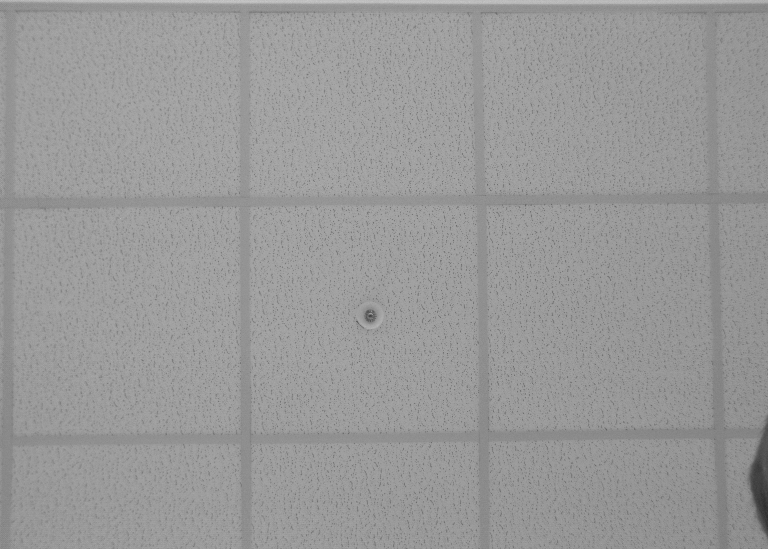Hello everybody,
I'm trying to write a program for a camera-calibration using the 4x11 asymmetric circle grid. I use a camera with 3840x2750 pixels. Although the pattern is recognized by the program most of the time, I'm not satisfied with the result of the calibration. Very often the undistorted picture seems to be more distorted than the original one. Nevertheless, Accuracy reaches values between 1 and 5 pixels. Also I'm interested in what is the best flag-setting for the calibrateCamera() command I added a simplified version of my code (especially the "while Camera is grabbing" part, but this is not the problem).
I'm grateful for every hint. Kind regards!
int main(int argv, char** argc)
{
vector<Mat> savedImages;
vector<vector<Point2f>> markerCorners, rejectedCandidates;
patternDimensions = Size(4, 11);
calibrationSquareDimension = 0.0177f;
vector<Vec2f> foundPoints;
// while Camera is grabbing
{
switch (character)
{
case ' ':
{
Mat temp;
frame.copyTo(temp);
savedImages.push_back(temp);
cout << savedImages.size() << ". Bild gespeichert" << endl;
}
break;
case 13:
if (savedImages.size() > 9)
{
string SaveFileName;
cameraCalibration(savedImages, CalibrationType, patternDimensions, calibrationSquareDimension, cameraMatrix, distanceCoefficients);
cin >> SaveFileName;
saveCameraCalibration(SaveFileName, cameraMatrix, distanceCoefficients);
mode = 0;
return;
}
break;
case 27:
return;
break;
}
}
}
void cameraCalibration(vector<Mat> CalibrationImages, int CalibrationMode, Size boardSize, float squareEdgeLength, Mat& cameraMatrix, Mat& distanceCoefficients)
{
vector<vector<Point2f>> checkerboardImageSpacePoints;
getPatternCorners(CalibrationImages, CalibrationMode, checkerboardImageSpacePoints, PostFoundPattern);
vector<vector<Point3f>> worldSpaceCornerPoints(1);
createKnownBoardPositions(boardSize, CalibrationMode, squareEdgeLength, worldSpaceCornerPoints[0]);
worldSpaceCornerPoints.resize(checkerboardImageSpacePoints.size(), worldSpaceCornerPoints[0]);
vector<Mat> rVectors, tVectors;
distanceCoefficients = Mat::zeros(8, 1, CV_64F);
double AccuracyOfCalibration = calibrateCamera(worldSpaceCornerPoints, checkerboardImageSpacePoints, boardSize, cameraMatrix, distanceCoefficients, rVectors, tVectors);
}
void getPatternCorners(vector<Mat> images, int CalibrationMode, vector<vector<Point2f>>& allFoundCorners, bool showResults = false)
{
SimpleBlobDetector::Params parameters;
parameters.maxArea = 100000;
parameters.minArea = 500;
parameters.filterByColor = false;
parameters.minDistBetweenBlobs = 25;
Ptr<FeatureDetector> blobDetector = SimpleBlobDetector::create(parameters);
for (vector<Mat>::iterator iter = images.begin(); iter != images.end(); iter++)
{
bool found = false;
vector<Point2f> pointBuf;
found = findCirclesGrid(*iter, patternDimensions, pointBuf, CALIB_CB_ASYMMETRIC_GRID | CALIB_CB_CLUSTERING, blobDetector);
if (found)
{
allFoundCorners.push_back(pointBuf);
}
}
}
void createKnownBoardPositions(Size boardSize, int CalibrationMode, float squareEdgeLength, vector<Point3f>& corners)
{
for (int i = 0; i < boardSize.height; i++)
{
for (int j = 0; j < boardSize.width; j++)
{
corners.push_back(Point3f((2 * j + i % 2)*squareEdgeLength, i*squareEdgeLength, 0.0f));
}
}
}
bool saveCameraCalibration(string FileName, Mat cameraMatrix, Mat distanceCoefficients)
{
ofstream outStream(FileName);
if (outStream)
{
int rows = cameraMatrix.rows;
int columns = cameraMatrix.cols;
outStream << rows << endl;
outStream << columns << endl;
double value;
for (int r = 0; r < rows; r++)
{
for (int c = 0; c < columns; c++)
{
value = cameraMatrix.at<double>(r, c);
outStream << value << endl;
}
}
rows = distanceCoefficients.rows;
columns = distanceCoefficients.cols;
outStream << rows << endl;
outStream << columns << endl;
for (int r = 0; r < rows; r++)
{
for (int c = 0; c < columns; c++)
{
double value = distanceCoefficients.at<double>(r, c);
outStream << value << endl;
}
}
outStream.close();
return true;
}
return false;
}



